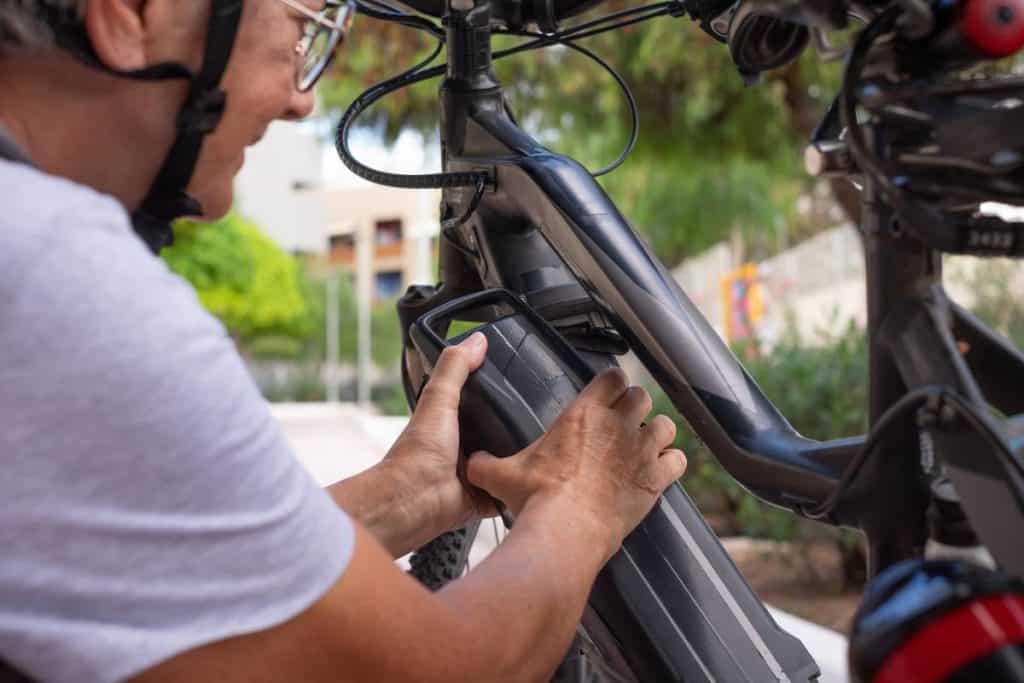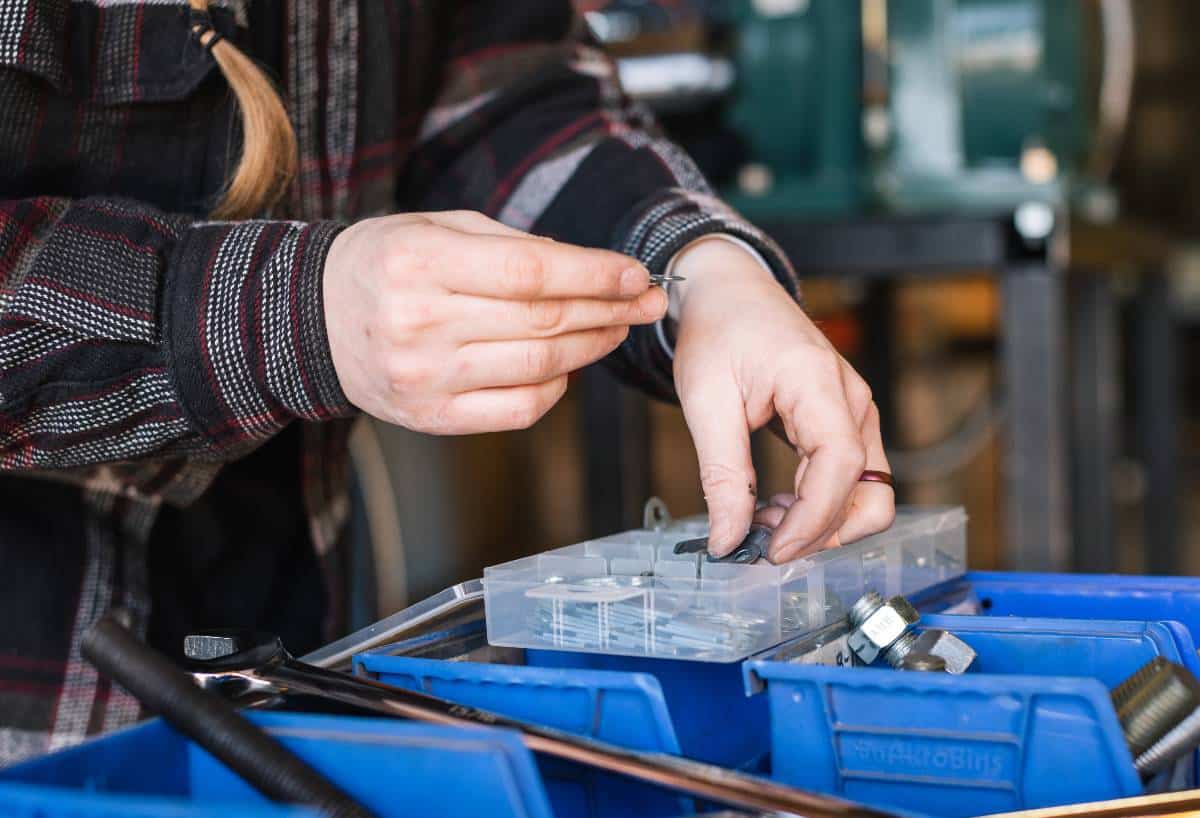E-bike Battery Recycling Program: What Is It?
As founder of Electrik Living, my mission is empowering wider e-bike and electric transport adoption to combat climate change. But with booming electric bicycle growth comes sustainability responsibility around eventual battery disposal. While e-bikes eliminate gas-powered miles, their complex lithium-ion batteries turn toxic if unsorted when spent. Disturbingly under 5% of lithium batteries get recycled today despite 63 million being sold annually.
I’m tackling these pressing questions about the end-of-life side of pedal electrification – exploring options so we can keep e-bikes truly clean. Come along on this journey towards responsible battery circularity!
Key Takeaways
- E-bike battery chemicals pose environmental hazards if landfilled
- Call2Recycle offers free national drop-off recycling
- Consumers should evaluate aging batteries for replacement
Why It Matters
Beyond letting e-bikes realize their emissions-slashing potential day to day, we have to ensure they remain eco-friendly long term. That means dealing with batteries responsibly when retired.
Toxic heavy metals plus flammable electrolytes make lithium batteries hazardous for landfills. Safe materials reclamation through recycling is essential.
As pioneers of an electric transport revolution, we must lead by example on sustainability – spurring the right recovery systems and culture around battery end-of-life care.
Doing right by the planet while educating fellow e-bikers feels especially meaningful to me as a dad who helped found Electrik Living upon my daughter’s Earth Day arrival!
What We’ll Cover
In this complete guide to responsible e-bike battery disposal, I’ll share:
- Recycling options for dead batteries
- How to gauge when replacement needed
- Improving transparency around programs
- Looking ahead to circular models
Let’s transform spent batteries from waste into renewable opportunity!
E-bike battery recycling program: What Is It?
With accelerating e-bike adoption, properly handling depleted batteries is crucial for sustainability. So what exactly does e-bike battery recycling entail? In essence, it’s the systematic process of safely capturing retired lithium packs and dismantling them to recover constituent metals and other materials in an environmentally responsible way rather than wasting resources or risking contamination from landfilling.
What is e-bike battery recycling?
E-bike battery recycling specifically refers to accepting used-up bicycle battery packs from consumers and then manually extracting parts like steel casings, plastic separators, and critical cathode metals including lithium, nickel, and cobalt. These separated commodity streams get sent for processing into recycled metals or compounds ultimately used in manufacturing new batteries or other items. So it closes the materials loop rather than losing valuable elements.
Importance of e-bike battery recycling
Responsibly recycling depleted e-bike batteries is tremendously important because it prevents hazardous waste from triggering pollution and health issues if dumped illegally. Lithium ion packs contain caustic electrolytes and heavy metals that leach out over decades when landfilled. Keeping these toxic compounds from accumulating to contaminate ecosystems and communities is essential. Plus recycling conserves natural resources otherwise wasted.
Process of e-bike battery recycling
The e-bike battery recycling process starts with consumers dropping off expired packs at public collection points which then ship consolidated batches to contracted sorting facilities. There, automated machinery dismantles battery assemblies into commodity streams before shredders liberate the raw cathode metals and compounds. These extracted elements finally get manufactured into fresh lithium-ion batteries or other products, closing the usage loop.

How Does an E-bike Battery Recycling Program Work?
Effective e-bike battery recycling programs require strong operational coordination between participants across the recovery chain. Key components include widespread consumer drop-off locations, retailer engagement to collect volumes, efficient transportation networks through logistics partners, dismantling at specialized facilities, and finally commodity sale to battery manufacturers. Well-designed programs make participating straightforward for users while ensuring environmental threats are responsibly mitigated.
Key components of an e-bike battery recycling program
Robust e-bike battery recycling programs involve multiple integrated components for seamless closed-loop functionality. These include accessible consumer drop-off points preferably with retail partners to aggregate volumes, storage/handling preparations meeting dangerous goods regulations, certified logistics carriers equipped for lithium Class 9 shipments, licensed dismantling sites with safe breakdown protocols, and certified smelters/refiners to process commodity outputs like steel or lithium salts into recycled materials usable for manufacturing new batteries.
Benefits of participating in an e-bike battery recycling program
Consumers and retailers benefit by easily fulfilling sustainability commitments when participating in e-bike battery recycling programs. Collection site ubiquity and prepaid shipping reduce barriers for example. Handled properly, hazardous lithium cells avoid landfills to prevent toxin leakage over decades too. And CO2 emissions shrink from mining fewer raw materials so recycled content use cuts overall product carbon footprints. These programs enable key stakeholders at each usage phase to share responsibility.
Challenges faced by e-bike battery recycling programs
E-bike battery recycling initiatives still face hurdles around public awareness and costs. Many consumers remain unaware of takeback options currently. And though programs often subsidize consumer-facing layers, untreated volumes lose money while producers lack mandated recycling targets in most regions. Passing regulations stipulating corporate Average Recycling Content standards for new products based on recycling rates helps drive growth though. As does consumer education around proper end-of-life battery practices.
Why should e-bike riders recycle their batteries?
With booming e-bike adoption, ensuring proper end-of-life battery management is increasingly vital. As pedal electrification pioneers, responsible recycling helps protect the planet while setting sustainability precedents. Hazardous materials and finite resources warrant careful handling when packs deplete after 500-1000 charges typically. Retailers like Trek progress recycling through initiatives easing consumer participation. So whether to mitigate contamination risks, conserve scarce elements for circularity, or lead by example shifting mobility green, recycle those expired batteries!
Environmental Impact of e-bike Batteries in Landfills
Left in regular landfills, e-bike batteries pose contamination and safety issues over the years as seals fail. Toxic electrolytes and heavy metals eventually leak, while lithium sparks fire upon exposure. With cells fracturing over decades amid waste piles, dangerous breakdown compounds accumulate underground before leaching into soil and water tables triggering health issues. Recycling mitigates environmental and health hazards.
Role of retailers in promoting e-bike battery recycling
Retailers like Trek bike shops play a crucial role in e-bike battery recycling by serving as visible year-round public collection hubs bridging programs with consumers. Stores promote sustainability, assist in securing tricky-to-remove batteries, and consolidate volumes boosting logistics efficiency. With most riders visiting retailers periodically for maintenance or upgrades, they’re perfectly positioned to facilitate recycling participation.
How individuals can responsibly recycle e-bike batteries
Riders help complete the circular lifecycle by dropping off expired e-bike batteries at retailers participating in recycling takeback centers or hazardous waste facilities. If detached, securely tape electrical contacts before transport. Compare programs like Call2Recycle to find the most convenient locations and learn any costs if applicable. With some retailers offering trade-in discounts on new replacement batteries, recycling that old pack makes double sense!
Impacts of Unrecycled E-Bike Batteries
Before detailing solutions, understanding what’s at stake when batteries go unprocessed drives home the urgency of proper systems.
Hazardous Waste Contamination
Lithium cells contain highly reactive materials like electrolyte solvents that leach toxins when damaged. Heavy metals also accumulate over decades if dumped as landfills break open.
Studies already detected soil and water contamination from the millions of tons of unanimated li-ion batteries disposed of annually. Worsening pollution spurs birth defects, organ damage, and ecosystem harm.
Risk of Catastrophic Fires
Should battery seal integrity fail, exposed lithium can ignite spontaneously when contacting air, vapor, or water. Unquenched by standard suppressants, these intense burns threaten whole waste management sites.
Australia suffers waste facility fires almost daily tied to illegally trashed devices with Li-ion batteries.
Routing packs for controlled recycling is essential for communities and the planet!

Call2Recycle’s Battery Recycling Program
The urgency I feel around battery waste led me to partner with Call2Recycle, providing free recycling drop-offs through their robust nationwide network.
Widespread Retail Recycling Hubs
With Call2Recycle, over 90% of Americans reside within 10 miles of one of their 200,000+ public collection sites situated at retailers, municipal waste centers, and community spots. Just enter your zip code on their site to uncover the nearest locations.
Retailer Support Offerings
The non-profit furnishes participating dealers with convenient battery collection points like recycling tubes or boxes. Outreach materials and promotional assets also help stores spread sustainability messaging to customers.
Consolidated National Logistics
UPS transports recovered battery batches from retailers to contracted processors, combining routes for efficiency. Call2Recycle foots the shipping costs as part of their free public service.
Safe Battery Breakdown
Certified partners then manually dismantle battery packs at specialized facilities to safely separate steel, plastic, and precious cathode metals like lithium, cobalt, and nickel. These outputs get recycled into new batteries or products.
I love Call2Recycle’s commitment to maximizing safe materials reclamation from hazardous e-waste!
Preparing to Recycle E-Bike Batteries
When an e-bike’s total range noticeably drops despite charges or the charging duration lengthens, replacing the battery looms. Follow the tips below for responsibly handling worn-out packs.
Checking Battery Health
Gradual power fading even after charges suggests aging. More severely, if bikes cut out well before the maximum range, have batteries tested. Expect 500 to 1,000 full cycles before liveliness declines.
Locating Nearest Recycler
Search Call2Recycle’s site for the closest public drop-off once replaced. Retail staff can assist in detaching fixed batteries too.
Transporting Safely
Use original battery packaging or non-conductive tape to secure contacts if directly conveying for recycling. Never transport damaged lithium battery cargo areas due to fire risks.
Stay vigilant to responsibly handle batteries for sustainability!
Expanding Recycling Infrastructure 2030
While Call2Recycle makes electric bike battery recycling accessible for 60% of Americans presently, continued infrastructure building is crucial to handle coming volumes.
More Collection Hubs
All metro regions must offer programs accommodating residents without transport access. Manufacturers could subsidize marginal rural recycling costs to prevent toxin leakage from illegal dumping.
Community Outreach
Despite established channels, under 20% of household battery waste gets recycled. Creative awareness campaigns highlighting hazards left unaddressed help prompt action.
Right to Repair Advocacy
Policy battles around consumer device fix freedoms could enable safer DIY battery replacements from third parties, expanding participation.
Keep advocating for infrastructure supporting circular energy transitions!
Future Battery Sustainability
Beyond recycling networks, better battery chemistry and circular business models promise further waste reductions from electrified transport.
Chemistry Improvements
Research on solid-state compositions without volatile electrolytes offers inherent safety and performance gains. Streamlined packs also allow easier material extraction.
Circular Lifecycle Design
Rather than shredding for raw commodity sorting only, deliberately engineering used packs for direct remanufacturing into new batteries saves resources.
Product-as-a-Service Models
An emerging option is leasing battery capacity via subscriptions, keeping manufacturers responsible for reclaiming materials. This incentivizes maximum value retention before safe recycling.
Pursuing fundamental improvements throughout the battery lifecycle multiplies sustainability.
PeopleForBikes: Uniting Voices to Strengthen Biking
PeopleForBikes is a nonprofit advocacy organization that aims to make bike riding better through various efforts including research, partnerships, coalition building, and engagement campaigns. As e-bikes drive strong growth in bicycling participation, PeopleForBikes is playing a role in convening industry leaders around the importance of battery sustainability.
Driving Policies Supporting Bike Infrastructure
One of PeopleForBikes’ key goals is pushing policies at all levels of government that better integrate bicycling infrastructure and supporting facilities into transportation planning and funding. As pedal-assisted models expand ridership demographics, the organization advocates for corresponding investments in charging stations and battery recycling hubs.
Educating Consumers on Cycling Benefits
PeopleForBikes conducts marketing promotions and public education on the personal and societal advantages of bike riding – from fitness to reduced environmental toll. Messaging also stresses proper end-of-life battery recycling etiquette as vital for e-bikes to sustain eco-friendly transport claims alongside daily use benefits.
Research Insights Informing Industry Innovation
With comprehensive cycling participation statistics and perceptions research, PeopleForBikes shares trends bike manufacturers apply toward design improvements. Their consumer battery disposal behavior surveys similarly help inform where expanded battery circularity interventions like takeback incentives would be most effective alongside benchmarking program maturity.
FAQs
How does lithium battery recycling work?
Specialist processors first manually dismantle packs to isolate hazardous materials. Steel, plastics, and cathode metals get separated into pure streams before shredding and sorting into alloys used to manufacture fresh batteries and other items.
Can I mail in my used e-bike battery for recycling?
Avoid mailing depleted batteries yourself given strict ground/air shipping restrictions around flammable goods. Instead, drop off at Call2Recycle sites facilitating consolidated logistics through their UPS partnership.
What should I do if my e-bike battery seems damaged?
Stop charging or using suspect packs immediately. Tape exposed contacts and then place them in a sealed non-metal container to contain potential leakage routes to hazardous waste facilities. Call a local environmental agency for a special pickup.
How does battery recycling help the planet?
Repurposing finite mined resources like lithium, cobalt, and nickel preserves elemental purity for circular reuse rather than wasting manufactured to virgin sourcing. Reclaiming heavy metals ensures toxins don’t accumulate in communities.
What types of batteries are typically used in e-bikes?
E-bikes commonly use lithium-ion batteries, which are known for their high energy density and long lifespan.
How can I design an industry-leading e-bike battery for recycling?
You can design an industry-leading e-bike battery by ensuring it is easily recyclable and collaborating with programs like Call2Recycle to establish a battery recycling program.
I welcome any other e-bike sustainability questions – please reach out!
Conclusion
Thanks for joining my journey towards responsible e-bike battery end-of-life management – a key pillar of genuine environmental friendliness as pedal electrification grows.
Please help spread awareness around recycling options and stay involved in advancing policy support expanding access and transparency further.
Together we can transform depleted batteries from wasted assets into the building blocks powering our clean transport future. My daughter Trinity and all children deserve that sustainable legacy.
Let’s continue the conversation around aligning sustainability best practices with our renewable energy vision at Electrikliving.com






